Remembering Bob: Stories about Bob Engel, biology professor emeritus
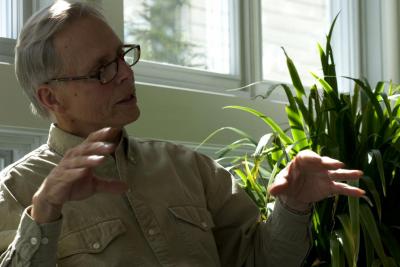
Nicknames
By John Hayes
Nicknames
Bob put his enormous vocabulary to use in surprising ways, often as euphemisms. Mixed grill referred to southern Vermont’s all-too-frequent mixture of snow, sleet, and freezing rain, which he hated. Free-flowing and sanitary referred ironically to the state of one’s digestive tract, particularly in regard to the aftermath of tropical biology field trips. Itzcuintlis (eats-queent’-lees), shortened version of the Mexican hairless dog name Xoloitzcuintli (which we corrupted to ess-quint’-las), referred to students’ parents.
He also liberally handed out nicknames, most of them less than flattering, except for those Bob held in deep respect, such as John MacArthur, who became Pa Pa (with the accent on the second Pa). Maybe others will share theirs on this website. Mine evolved in about 1980 on a spring break Florida ornithology field trip.
Just prior to spring break, I traveled to Ohio along with my then-wife, Joanne, and our daughter, Stefanie, to attend a greenhouse conference. The plan was to catch up with the Marlboro field trip already under way at Stephen Foster State Park in the Okefenokee Swamp in Georgia. Unfortunately, along the way we had one of those Saab stories (brakes) and were delayed a day. Bob and the students were nowhere to be found when we arrived at the park. But I knew in those pre-cell phone days that he would leave us a note.
When we didn’t find a note in the campground, we went to the ranger station, but the on-duty ranger couldn’t find a note for John Hayes. So, we went back to the campground to look again. Nothing. Back to the ranger station. Again, no note for John Hayes. After ruminating for a while about the lack of a note, Joanne went back in and said, “Are there any notes at all back there?” The ranger looked around and said, well, just this one, for “Meatloaf, Mrs. Loaf, and Little Burger.” Hah!
We met them the next day at the southern tip of Lake Okeechobee, and I became Loafy from then on.
Field Trip Highlights
By John Hayes
Georgia Karma. In the early days, not having access to a college van, we drove cars on field trips. When we camped at Stephen Foster State Park in the Okefenokee Swamp in Georgia, signs warned about feeding the wildlife. Ignoring those and Bob’s stern lectures about helping wildlife become too used to humans, Dan Brown fed peanut butter out of a half-filled gallon jug from the dining hall to the abundant raccoons. Sometime in the middle of the night, Jon Friedman awoke to find about a dozen raccoons, having climbed in through the open sun roof, inside Dan Brown’s Saab. They had opened the peanut butter container and spread oily tracks all over the cloth seats. It doesn’t seem like Bob could have dreamed up a better “I told you so” moment.
Costa Rica Body Surfing. In January 1981, Bob, John MacArthur, my then-wife Joanne, our daughter Stefanie, and I traveled to Costa Rica. For part of the trip, we camped out on Playa Naranjo in Santa Rosa Park to watch enormous leatherback turtles lumber up the beach to lay eggs while bioluminescent dinoflagellates lit up the surf with each crashing wave and the Southern Cross and other constellations that we can’t see in Vermont lit up the night sky. During the day, we body surfed on gigantic waves that tossed us head over heels up onto the beach. While Bob and I treaded water waiting for the next big wave, all of a sudden Bob took off swimming for the beach. When he got about half way there, he turned and yelled “Shark!” I looked around to see a giant fin out of the water maybe 20 feet away from me. Statistics show that sharks kill only about 5 people each year worldwide. Fortunately for me, I was not one of them. Bob undoubtedly knew about the low probability of attack; otherwise, why would he have taken off for the beach before pointing out the fin?
Red in Tooth and Claw. Students over the years have parodied Bob’s “love for all life forms.” We’ve watched him let mosquitoes bite him rather than squash them. He didn’t reflexively pull away when critters got a hold of him when he held them loosely, not wanting to hurt them. Invariably, some of these led to blood, often lots of it, such as the time a collared lizard clamped down on his finger in a California Joshua tree woodland, or when a garter snake grabbed the back of his hand in Yellowstone Park, or when someone’s or his own parrot bit down on his hand while handling them. No matter how hard most of us try, it’s almost impossible not to jerk one’s hand away when one is about to be or is being bitten. How Bob always held steady is an eternal enigma.
Hernias, B Hole, and Cactuses. While in Oaxaca on a tropical biology field trip, Bob was feeling “puny.” We took him to a clinic where the doctor diagnosed a hernia, which he wanted to operate on immediately. Unsurprisingly, Bob did not want to go under the knife deep in southern Mexico. So, we made a group decision to start out that night and to drive our several vehicles around the clock to McAllen, Texas, about a 20-hour drive, but extended 2 hours by getting split up in Mexico City. (So much for everyone’s advice not to drive at night in Mexico.) Bob wasn’t able to drive, so he tried to sleep in the back of B Hole, his Volkswagen bus, of which he was very protective. If you got above 60 mph, he could tell by engine pitch, and he would shout out to slow down. Of course, we wanted to spend as little time driving as possible, so there would be frequent shout outs. Along the way, we stopped by a field to pee. All of a sudden there was screaming, as Joanne had squatted on a cactus in the dark. Thanks to Kathy Welling and Chuck Hutchinson, Joanne was relieved of the cactus spines. Of course, with all the commotion, Bob roused from the back of the bus. When he found out that it was just a cactus and not a rattlesnake, there were recriminations about too much noise. Off we went again, arriving at the border at dark. At a clinic in Texas, Bob found out that he didn’t have a hernia and that all he needed were some little pills that would cause “some action” a little later. Having risked life and limb and cactus spines driving through the Mexican night, it’s no wonder that later on we came up with some descriptive phrases for Bob’s ailment, such as “Hernia, my ass” and “Bob sure had a shit-eating grin on his face when he came out of that McAllen clinic” and “Next time, we’re going to make sure that Bob drinks the water.”
Beauty and Ecology
By Jenny Ramstetter '81
I thought I might do better today if I started by thinking of someone else’s words instead of my own. In January, I began Robin Wall Kimmerer’s book Braiding Sweetgrass, and then I found Gathering Moss, by the same author, on Bob’s bookshelf.
In her essay, “Asters and Goldenrod,” Kimmerer reflects on her journey as a botany graduate student. She finds brilliant goldenrod in flower growing alongside its perfect counterpart the “full-on royal purple,” New England Aster. She writes, “Purple and gold . . . a regal procession in complementary colors. I just wanted to know why. Why do they stand beside each other when they could grow alone? Why this particular pair? . . . is it only happenstance that this magnificence of purple and gold end up side by side? What is the source of this pattern? Why is the world so beautiful? . . . It seemed like a good question to me. But my adviser said, ‘It’s not science.’” I knew Bob would have had a much more interesting response for a student who asked those questions, and I thought of how Bob shaped my life as a scientist and as a person.
I grew up mostly in Colorado, but my mom and brother and I moved to California for two years. As an 8-year old, I lived two streets away from Bob in Isla Vista as he began grad school at UCSB, though I can’t say if our paths ever crossed. Along the beach, I explored tide pools most every day, and on the bluffs above I made flutes from the non-native bamboo stalks. I watched in amazement as monarchs migrated in an undulating wave along the coast in groves of eucalyptus. On school trips, we went to the Santa Ynez Mountains and, according to my teacher, we saw one of the last California Condors flying free at that time. Back in Colorado, I returned to feeding grasshoppers blades of grass, rescuing baby birds, having garter snakes wrap around my arm, and chasing robins from the worms they were stretching from the soil. From elementary school through high school, I was fascinated by any living critter, but talked myself into the idea that I wasn’t good at science or math, and most of my science teachers did little to dissuade me of that notion. Instead of being a scientist, I would simply love the beauty in nature and leave its study to others. Ten years after my time along the Pacific coast, I headed east to Marlboro sight unseen. On my first day at the college, a VW van parked in front of the dining hall and filled with tropical plants and two parrots and Popcorn the dog piqued my interest. A day later I was on an Amtrak train to Montreal with the owner of that van and others here today so that we could ride our bikes the length of Vermont before starting the semester. On that bike ride from Montreal to Marlboro, we stopped along the road under the shade of trees I didn’t know and Bob picked up an acorn and asked many questions while admiring the acorn. I knew none of the answers, but I wanted to find out, and Bob’s awe and curiosity in a simple acorn were contagious.
These 40 years later, I’ve shared many moments of ecology and appreciation for life’s beauty with Bob including a desert biology field trip that ended in California. We went to the Santa Ynez mountains, and a large Coulter pine cone now lives in the science building from that trip. The last magical days of the field trip were spent on Santa Cruz Island off of the coast of Isla Vista hosted by one of Bob’s graduate school buddies and life-long friends; I thought back to when I stood on the beach as a kid looking out at Santa Cruz and wondering what treasures that island held. As with many of you, Bob was my teacher, mentor, colleague, and friend. I treasure it all, but I suppose I circle back to beauty most of all. A year ago April, my kids were on a Junior High class trip to Costa Rica, and I emailed Bob to tell him that they’d just seen a Resplendent Quetzal in the Monteverde cloud forest. Bob wrote back: “Yikes. I hope they understand what this boils down to: ‘The most spectacular bird in the western hemisphere,’ quoting Roger Tory Peterson.”
Bob saw beauty in spectacular birds and in the acorn. And he saw beauty in all of you and in a sweeping motorcycle ride. We will remain touched in both small and in life-changing ways by Bob. In moments when I might inspire or support family, friends, and students, I know it’s partly because of what I learned from Bob. Though it’s not a word he would use, I am blessed by all of you who knew Bob and cared for him and helped me so much during his illness and death. I am so grateful. I especially thank Brian and Senait and Zinabu who have lived with the burden of my sadness for many days and months now. In the past quarter century, the few times when Brian couldn’t fully comfort me, he would call Bob who would scoot over on his motorcycle, or car if need be. Bob would listen, usually make me laugh, and help me to figure out what to do next.
Now, I turn to all of you who have been touched by Bob, near and far and friends who couldn’t be here today. I know that the beauty of Bob’s life and our bonds together will help us all to care for each other and to care for the beauty of life around us just a bit more.
Toward Sicily
By Joanne McNeil Hayes
For Bob, July 2017
Sicilian heat rises
against red earth
inches toward buff clouds
like birds in open air.
What if passion is insecure,
playful, disheartened by silence?
If so, we turn to sunflowers
and love them in the shade or under water,
and when they dry to scrub and
blow listless in the wind,
we know that lives have passed us by.
We enter through a pastel sleep where
deep red moros hug the sky and
rain turns sunset a cobalt blue.
Poem for 3 Johns and a Bob
To come!
Arizona Visit
By Tim Tibbitts '80
I take some solace from remembering the last time I saw Bob in person. Not too many years ago, he took a solo spring break trip; flew to Phoenix, rented a snazzy motorcycle, and went on a road trip around Arizona. Toward the end of his trip, he spent a few days visiting in the tiny, remote town where I lived. I was amused, trying to reconcile the motorcycle fanatic with the man I first knew decades before. He was semi-retired, and still delving into new things with great passion. He was very happy and relaxed. We went for a few jaunts into the surrounding desert (not on the motorcycle) and spent a lot of time talking, back at the house. The morning he headed back to Phoenix, he rolled out the driveway in his silver motorcycle “moon suit,” waved, and flashed that big grin. 30 years after being his student, I was still—in fact more—impressed with his unique character. He wasn’t just a gifted teacher and brilliant biologist. He was also articulate, learned, and had great integrity, curiosity, humor, discipline, mischief, loyalty, and compassion. He improved the world with his time here.
Eyes for the Natural World
By Janet Humphrey '81
Bob was my professor and lifelong friend. I know I’m one of many whose life he changed in a most profound way, infusing it with his intelligence, spirit, wit and vision. I got to housesit for him one summer while he went out on the desert trip with John Hayes and a group of students, and cared for his menagerie‚dogs, birds, fish, roving turtle (and rubber snake on the greenhouse floor that I initially assumed was an actual pet!). I told him many times that he had given me the eyes with which to see the natural world. He taught me how to look at ecosystems and how to be inquisitive, and I carried that with me wherever I traveled. I’d usually email him for his thoughts on each different environment I visited. In a typical response, Bob said of Ecuador, “I went to the Galapagos with buddies and had a brief stop on the mainland...including a short trip to a nectar feeding reserve at 11.5 K feet. Fuchsias in bloom and saber-billed hummers with bills as long as the body.” He never stopped learning and teaching. I am so grateful to have known him and privileged to have called him my friend.
Naturally Gifted Teacher
By Peter Niewiarowski '84
When I came to Marlboro in 1979, I didn’t even know what Biology was. Then I took a class from Bob Engel, and I never looked back. I heard somebody say recently that Bob was a master teacher. It’s a massive understatement. He was a deeply and naturally gifted teacher. He blended brilliance, passion, empathy, comedy, and curiosity into every meeting, class or otherwise, that I had with him. As a mentor to me during the stages of my plan of concentration, he treated me as a colleague by critiquing my ideas. But he also nurtured me by always displaying his confidence in me and in the notion that I could make a substantive contribution to our knowledge about the world. I saw him do this with all his students, and it is clear he built a legacy on it. Bob and his co-conspirator John Hayes were chief architects (helped by other faculty and student sidekicks) of the academic climate that pervaded the science building. They were at once playful, serious, pranksterish, rigorous, humble, and opinionated. When I left Marlboro, I came to understand that this academic environment was uniquely Marlboro …an environment that Bob built, but one that also built Bob. I feel extraordinarily lucky to have been quite accidentally drawn in to it.
No Sharing
By Tom Good '86
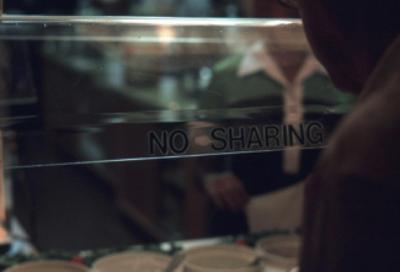 I was fortunate enough to be able to go on several Marlboro field trips, including trips to the desert southwest, the southeastern U.S. (Okefenokee, Everglades, etc.), the Yucatan Peninsula, and interior/central Mexico – a.k.a “the Campsite”). These were formative trips for a budding biologist, and spending time with Bob and John Hayes (and John MacArthur!) was invaluable.
I was fortunate enough to be able to go on several Marlboro field trips, including trips to the desert southwest, the southeastern U.S. (Okefenokee, Everglades, etc.), the Yucatan Peninsula, and interior/central Mexico – a.k.a “the Campsite”). These were formative trips for a budding biologist, and spending time with Bob and John Hayes (and John MacArthur!) was invaluable.
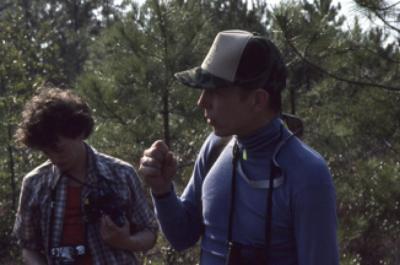 A favorite Bob/trip memory of was on the southeastern U.S. ornithology trip. We would often purchase lunch fixings (tortillas, refried beans, canned chilies, etc.) for our roadside lunches. A joke on the trip was that Bob would fend off others from his lunch supplies during these roadside lunches with a curt “no sharing.” Later in the trip, I snapped a pic (top) of a salad bar at a restaurant dinner stop to share at our traditional post-trip slideshow. Its inclusion was ironic and funny, as Bob was an inveterate sharer of knowledge (right), which in the field as in the classroom, was extensive. I never see a restaurant sign prohibiting sharing without cracking a smile and thinking of Bob. The Mexico trip also produced pics of Bob’s photogenic sides (below).
A favorite Bob/trip memory of was on the southeastern U.S. ornithology trip. We would often purchase lunch fixings (tortillas, refried beans, canned chilies, etc.) for our roadside lunches. A joke on the trip was that Bob would fend off others from his lunch supplies during these roadside lunches with a curt “no sharing.” Later in the trip, I snapped a pic (top) of a salad bar at a restaurant dinner stop to share at our traditional post-trip slideshow. Its inclusion was ironic and funny, as Bob was an inveterate sharer of knowledge (right), which in the field as in the classroom, was extensive. I never see a restaurant sign prohibiting sharing without cracking a smile and thinking of Bob. The Mexico trip also produced pics of Bob’s photogenic sides (below).
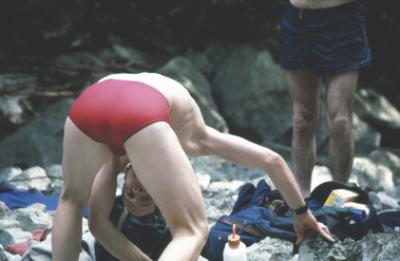
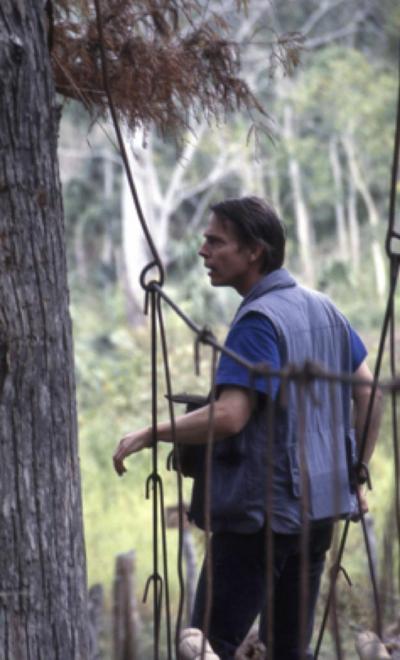
A Really Rare Warbler
By Dianna Noyes '80
When we learned of Mallory’s death and Bob’s diagnosis last summer, I was in Umbria, Italy, for the first time, looking out at a view that could have been one of Mallory’s paintings. When we learned of Bob’s death, we were in the desert on the outskirts of Tucson, Arizona—another new environment for me, but one that Bob knew and loved so well. In the short intervening months, I only saw Bob once, when I took him to a radiation appointment in Keene. We talked of many things, wandering around from subject to subject—mutual friends, birds, Italy, the Catholic Church, pedophiles, age, motorcycles. On the way home, we stopped at the Chelsea Royal for Mayan chocolate ice cream cones. We sat on a bench out back, overlooking the marshy field. It was a stunning late summer day. Red-winged blackbirds chortled on cattails. A little breeze wafted through. I looked at Bob, already diminished, already starting to disappear, and thought, “this may be the last time I see you, spend time alone with you. I’d better try to make you laugh,” for that is one of the things I loved most about Bob—his laugh. So I said something, and here it came, that muffled deep in the chest wave of glee that rose in pitch through his sternum and up his throat to come out his mouth in a little burst of delight and surprise. The thing that I did not say, and wish I had, was “thank you.” Thank you, Bob, for letting me believe in my nascent birding days that the brown creeper I saw in January was really a rare warbler. Thank you for pointing out my first redstart; for confiding in me that you weren't confident about presenting a talk on moss and lichens; for teaching generations of students whether we were in your classes or not; for the love, patience, and attention you bestowed upon us; and for the laugh that I can still hear and will always treasure.
A Uniquely Social Animal
By Tim Tibbitts '80
There are so many memories of Bob, it is hard to pick just a few. The breadth of his knowledge and skills as a biologist and teacher are legendary, and perhaps others have better stories than me. A different aspect on him occurred to me. You and another person or two made comments about Bob’s occasional somewhat antisocial moods. He even admitted as much, in some of his later visits and correspondence with me. But we all change with age, including characteristics like that. My memories of Bob from my time as a student, and for many years later, are that he was a uniquely social animal. He was very comfortable, very adept with making new acquaintances, and putting people at ease. I saw this in both his professional work and his social interactions. Examples:
His classroom technique was typically playful, mischievous and engaging. But absolutely thorough. He made learning an intellectual game. He effectively seduced people into learning and into gaining his passion for biology. When he made demands on students, it was not intimidating, it was encouraging. He could put you at ease at the same time he put you on the spot.
His persona out in the larger world was instructive and set an example for others. I remember visiting a small limestone cavern on private property in Texas (?) on a desert biology field trip. Our “guide” was a youngish woman who clearly was not much educated, nor very sophisticated. It was clear Bob knew a lot more about the geology, hydrology, and biology of limestone caverns in Texas than she did. But he was the epitome of grace and tact in talking with her as he taught us. He put her at ease, complimented her sincerely, and had yet another fan by the time we departed.
There was our stay at the university field station on South Water Caye off the coast of Belize in January 1980. The “university” was a large wood frame field house on an otherwise uninhabited spit of sand and coral rock. Two wonderful matronly Caribbean ladies cooked our meals and maintained the house. I remember lying in my sleeping bag on the wooden deck, trying to get to sleep, and hearing Bob and those ladies laughing it up down in the kitchen for what seemed like hours. Almost every night. They had very little in common with Bob, but there he was, gregarious and socializing and making new friends for himself and us.
In later years, I sometimes joined (or was joined by) Bob and John Hayes as they led subsequent desert biology field trips. I was impressed at how they continually improved their teaching. A lot of that was technical, but a lot was also the evolution and maturing of personalities. With time, Bob seemed even more relaxed and personable with his students and with the people they encountered on such trips. I remember them joining me and some coworkers on projects, and Bob was instantly familiar and casual with my peers. Even more, he drew them into discussions for the group, making them feel like they contributed to the teaching value of the outing. He didn’t have to do that, and he didn’t do it to be politic. He did it because that was his nature.
On one of his last visits with me in AZ, Bob did come alone, completely non-social, just him on his rented motorcycle. I was amused, as he fussed and tinkered with the bike in my carport. I marveled at how the Bob I first knew 30 years earlier (!) had morphed into a motorcycle enthusiast wearing what he called his full-body “moon suit.” He told me about how, several days earlier, he had gone into a small restaurant in rural eastern AZ wearing that moon suit. That is a geographic area I knew to be very suspicious of strangers, and people who “look different.” The story he told was hilarious, self-deprecating, wise and gracious. That was probably the last time I saw him. As always, he still gave off a glow.
Best Evidence Available
By Jim Tober
In 1983, when Bob was facing treatment for his leukemia, he walked me down the hall to his office where he had drawn a couple of lines on the blackboard—one descending and one ascending, with time on the horizontal axis.
What exactly the lines represented, I don’t recall, but clearly this graph summarized for Bob what was the best evidence available in deciding whether and when to undergo a marrow transplant. Waiting long enough but not too long was, I think, the bottom line.
Bob was an uncommonly good naturalist and teacher, clearly explaining complex realities with a personal observation, a succinct account of the most recent scholarship, a humorous story. And, he was a first-rate scientist, committed to rigorous, fact-based analysis, whether applied to to the marine rocky intertidal zone (his Ph.D. subject), proper motorcycle gear (a more recent passion), or his own highly consequential medical decision-making.
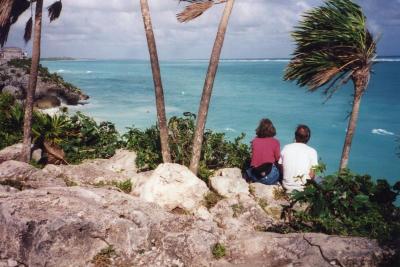 Forward to 1994/95 and the memorable field trip to Mexico and points south. I recently found my photographs from that trip which, true to form, feature too many images of Mayan sites and not enough of my fellow travelers. But, there are Mallory and Bob, sitting together looking out over the ocean near Tulum. I thought at the time I should capture that lovely scene, which is all the more lovely now.
Forward to 1994/95 and the memorable field trip to Mexico and points south. I recently found my photographs from that trip which, true to form, feature too many images of Mayan sites and not enough of my fellow travelers. But, there are Mallory and Bob, sitting together looking out over the ocean near Tulum. I thought at the time I should capture that lovely scene, which is all the more lovely now.
Fence Lizard on Her Face
By Joanne McNeil Hayes
Sceloporus occidentalis, for Bob
Fence lizard sunning on her face
sounds like a worrisome thing
but with sweet pearly eyes and
soft sticky bare feet
it clings to her cheek for a rest.
So there is no need to hide
from a critter dressed in
yellow striped pants
and sparkling blue vest
who stops by for just a brief visit.
Forests with Bob
By John Hayes
Jenny Ramstetter, in teaching Forest Ecology in spring 2018, asked some of us if we had photos of Bob in various forests. Most of us, unfortunately, just had slides from bygone pre-digital days. But that got me thinking about forests and some other habitats I had visited with Bob.
For Bob, the more diversity the better. Perhaps many would recall Bob's hand-typed desert plant lists. On most desert trips, we made it to the Mojave, but on some we didn't. But you can bet we spent more time in the species-rich Sonoran than in the other deserts. Something about those summer monsoons and winter rains.... But Bob was also fascinated by oak diversity in Big Bend National Park, Texas, in the Chihuahuan Desert. Then, when he spent a sabbatical on the Mexican plateau, he worked with a guy who was a reputed expert on oaks. Ultimately, I don't think he was impressed with the guy’s knowledge of the oaks. Bob said that because of hybridization the taxonomy was a mess.
I know that Bob was in awe of the irregularly flowering dipterocarp forest of the Borneo lowlands, as in the Danum Valley conservation area, with its 200 foot-tall trees. I have a slide somewhere of Bob and Kermit standing in front of one of those enormous buttressed trees.
He was also awestruck by the fauna diversity of the African savannah, as we saw in Namibia's Etosha National Park (Jenny was there).
Of course, who wouldn’t be awed by the redwood forests, but on our few field trips in that area, Bob made sure we visited Los Padres National Forest above Santa Barbara to see its incredible plant diversity, especially the manzanitas.
And I know Bob and John MacArthur were intrigued by warbler diversity in the Appalachian forests. Was it really nearly 60 years ago that Robert and John MacArthur published that Ecology article on bird species and foliage-height diversity?
Is there anywhere that didn't intrigue Bob? I think that you could have set him down anywhere on the planet, and he would have known where he was. How could one person know so much about so many plant and animal species?